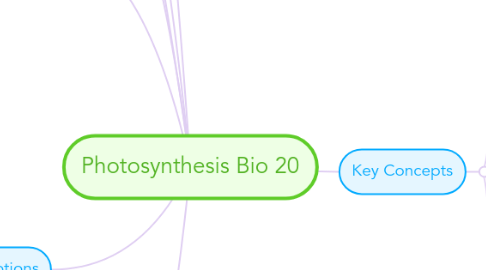
1. Before Bio 20
1.1. Science 7 Unit B: Plants for Food and Fibre
1.1.1. Students should have a general understanding of the process of Photosynthesis
1.2. Science 10 Unit C: Cycling of Matter in Living Systems
1.2.1. Students should be able to identify plant structures and understand their role in photosynthesis
2. General Outcomes: Students will...
2.1. "... relate photosynthesis to storage of energy in organic compounds"
2.2. "...explain the role of cellular respiration in releasing potential energy form organic compounds"
3. Misconceptions
3.1. Grade 11 students thought that plants get their energy from water, soil, air, worms, fertilizer and insects
3.1.1. (Cepni, S., Tas, E. & Kose, S. (2006). The effects of computer-assisted material on students' cognitive levels, misconceptions and attitudes towards science. Computer and Education 46(2), 192-205)
3.2. In many textbooks the simplified equation that shows the biochemical process of photosynthesis is inaccurate, which instills many student misconceptions. Many students struggle with the concept that CO2 taken from the air is what contributes most to a plants biomass.
3.2.1. (Ray, A.M. & Beardsley, P.M. (2010). Overcoming student misconceptions about photosynthesis: A model and inquiry based approach using aquatic plants. Science activities: Classroom projects and curriculum ideas 45(1), 13-22)
3.3. Grade 8 students perceived photosynthesis as a gas exchange process during which carbon dioxide is taken in and oxygen is given off.
3.3.1. (Balci, S., Cakiroglu, J., & Tekkaya, C. (2006). Engagement, Exploration, Explanation, Extension, and Evaluation (5E) Learning Cycle and Conceptual Change Text as Learning Tools. Biochemistry And Molecular Biology Education, 34(3), 199-203.)
3.4. Research suggests that the most difficult problem influencing students' understanding is the energy aspect of photosynthesis. There is misconceptions about how that energy is adsorbed, what it is used for and how plants create their own food.
3.4.1. (Balci, S., Cakiroglu, J., & Tekkaya, C. (2006). Engagement, Exploration, Explanation, Extension, and Evaluation (5E) Learning Cycle and Conceptual Change Text as Learning Tools. Biochemistry And Molecular Biology Education, 34(3), 199-203.)
3.5. Students do not understand the role that photosynthesis plants in the ecosystem, or that CO2 and H2O are absorbed by the plant to produce organic materials. They also struggle with concept of energy exchange that occurs during photosynthesis, as well as the concept that plant nutrition differs from animal nutrition.
3.5.1. (Ozay, E. & Oztas, H. (2003). Secondary student's interpretations of photosynthesis and plant nutrition. Journal of Biological Education 37(2), 68-70.)
3.6. Students have no problem with the “when” and “where” of photosynthesis, but rather, 45% of students do not understand the role of chlorophyll, its importance, and where it appears in the photosynthetic reaction.
3.6.1. (Marmaroti, P., & Galanopoulou, D. (2006). Pupils' Understanding of Photosynthesis: A Questionnaire for the Simultaneous Assessment of all Aspects. International Journal Of Science Education, 28(4), 383-403.)
4. After Biology 20
4.1. Post Secondary
4.1.1. Introductory Biology
4.1.2. Botany
4.1.3. Microbiology
4.2. 30-level courses
4.2.1. Biology 35 IB
5. All items not cited taken from: Alberta Education. (2007).Biology 20-30 [Program of Studies]. Retrieved from https://education.alberta.ca/media/654841/bio203007.pdf
6. Purpose
6.1. How does light energy from the environment enter living systems?
6.2. How is energy from light converted to chemical potential in organic matter?
6.3. How is the energy in organic matter related for use by living systems?
6.4. How do humans in their application of technologies impact photosynthesis and cellular respiration
7. Student Profile
7.1. Academic stream
7.2. Post secondary preparation course
7.3. Majority grade 11
8. Key Concepts
8.1. Light-dependent and independent reactions
8.1.1. Light Dependent Reaction
8.1.1.1. Important because the reaction produces ATP and NADPH which are used in the light independent reactions which in turn produces food for plants in the form of glucose.
8.1.1.1.1. Happens across thylakoid membranes
8.1.1.1.2. Energy in the form of light is adsorbed by photosystems and transferred through integral membrane protiens which catalyze light reactions. This is the Electron Transport System. This energy transfer produces NADPH and ATP.
8.1.1.2. Steane, R. (27, October 2011). The light-dependent reactions of photosynthesis. Retrieved from http://www.biotopics.co.uk/a2/light-dependent_reactions.html
8.1.2. Light Independent Reaction
8.1.2.1. Important because the reaction reduces carbon dioxide to create glucose which is food for plants
8.1.2.1.1. also known as the Calvin cycle
8.1.2.1.2. The starting material, carbon dioxide is take in to the plant through stomata in the leaves
8.1.2.1.3. Carbon dioxide is fixed, or converted into an organic compound when it reacts with RuBP
8.1.2.1.4. As the carbon dioxide goes through the Calvin Cycle it reacts with the proton in NADPH or ATP and becomes reduced. Through several reductive steps glucose is created.
8.1.2.1.5. The light independent reactions are cyclic because through further reaction the carbon dioxide drivative regnerates into RuBP and can be used to restart the Calvin cycle
8.1.2.2. Steane, R. (12, September 2006). The light- independent reactions of photosynthesis. Retrieved from http://www.biotopics.co.uk/a2/light-independent_reactions.html
8.2. Photosynthetic Electron Transport Systems
8.2.1. Importance of key understandings
8.2.1.1. Without thorough knowledge of the electron transport system, students would not understand how light dependent reactions occur in photosynthesis
8.2.2. Where light dependent reactions occur
8.2.3. Creates proton gradient using the energy from light to break the H+ from H2O
8.2.3.1. Uses this proton gradient to transfer electrons down the ETS
8.2.3.1.1. Final products are ATP and NADPH
8.2.4. For image of ETC go to: http://student.ccbcmd.edu/~gkaiser/biotutorials/photosyn/images/u4fg44.jpg
8.3. Absorption of Light by Pigments
8.3.1. Pigments are substances that absorb light
8.3.1.1. Types of Pigments
8.3.1.1.1. Chlorophyll a
8.3.1.1.2. Accessory Pigments
8.3.1.2. Found in chloroplasts (in the leaves) of plants
8.3.1.3. Pigment molecule absorbs photon of light
8.3.1.3.1. molecule moves into an excited state
8.3.1.4. Reece, J.B, Urry, L.A, Cain, M.L., Wasserman, S.A., Minorsky, P.V, & Jackson, R.B. (2011). Campbell Biology (9th ed.). San Francisco, CA: Benjamin Cummings Publishing Co.
8.3.2. Importance
8.3.2.1. Absorbs photons and begins process of photosynthesis
8.3.2.2. Is the reason for the green colour of plants
8.3.2.2.1. reflects green light waves and absorbs red and blue
